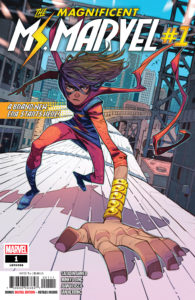 The Magnificent Ms. Marvel #1 (Legacy #58) — Writer: Saladin Ahmed; Pencils: Minkyu Jung; Inks: Juan Vlasco; Colors: Ian Herring
The Magnificent Ms. Marvel #1 (Legacy #58) — Writer: Saladin Ahmed; Pencils: Minkyu Jung; Inks: Juan Vlasco; Colors: Ian Herring
The Unbeatable Squirrel Girl #42 (Legacy #50) — Writer: Ryan North; Art: Erica Henderson, Naomi Franquiz and Derek Charm; Colors: Rico Renzi
Shuri #6 — Writer: Vita Ayala; Art: Paul Davidson; Colors: Triona Farrell
Age of Conan: Belit #1 (of 5) — Writer: Tini Howard; Art: Kate Niemczyk; Colors: Jason Keith
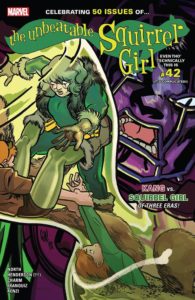 Runaways #19 — Writer: Rainbow Rowell; Art: Andres Genolet; Colors: Triona Farrell
Runaways #19 — Writer: Rainbow Rowell; Art: Andres Genolet; Colors: Triona Farrell
A common comic stereotype by non-comics readers is that they’re “adolescent male fantasies,” but Marvel’s been building a line of female heroes, often aimed at a teen/YA audience, that offers smart, engaging characters, diverse casts, and well-told tales that often have themes of tolerance and community. Ms. Marvel, a Muslim New Jersey teenager with Elastigirl-like shapeshifting powers, helped start the trend with her debut five years ago. Her creator and writer, G. Willow Wilson, just left, and The Magnificent Ms. Marvel is a relaunch with new writer Saladin Ahmed and artist Minkyu Jung; they manage to  keep the combination of family/civilian relationships and superhero action, and the cartoony/kinetic visual style, of the original, and, although this first chapter ends up in horror territory, it’s not likely to stay there; Ms. Marvel isn’t the kind of book to put much stock in downbeat endings, at least not permanent ones. That’s even more true of Squirrel Girl, another relative old-timer; it’s been unique since it started, 50 issues ago, and this anniversary celebration, with a done-in-one story and some guest pages from original artist Erica Henderson (and script from original — and, so far, only — writer Ryan North), is a perfect example of its subversive, heartfelt humor and
keep the combination of family/civilian relationships and superhero action, and the cartoony/kinetic visual style, of the original, and, although this first chapter ends up in horror territory, it’s not likely to stay there; Ms. Marvel isn’t the kind of book to put much stock in downbeat endings, at least not permanent ones. That’s even more true of Squirrel Girl, another relative old-timer; it’s been unique since it started, 50 issues ago, and this anniversary celebration, with a done-in-one story and some guest pages from original artist Erica Henderson (and script from original — and, so far, only — writer Ryan North), is a perfect example of its subversive, heartfelt humor and 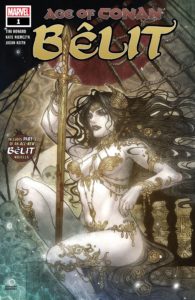 charm. Shuri, featuring the ultra-smart scientist who’s also the Black Panther’s sister, is part of a stable of books with brilliant problem-solving heroines (like The Unstoppable Wasp and Ironheart), who can navigate STEM disciplines better than anyone this side of Tony Stark or Reed Richards; it makes sense that this issue would guest-star the Miles Morales Spider-Man, since he not only fits comfortably into the same story trends but also is having his own media moment right now. Watch as they science and swashbuckle their way through a series of increasingly-dangerous encounters, culminating with the last-page arrival of another familiar face, and you’ll see why these kinds of stories are popular — especially with the impressionistic, colorful art from Paul Davidson and Triona
charm. Shuri, featuring the ultra-smart scientist who’s also the Black Panther’s sister, is part of a stable of books with brilliant problem-solving heroines (like The Unstoppable Wasp and Ironheart), who can navigate STEM disciplines better than anyone this side of Tony Stark or Reed Richards; it makes sense that this issue would guest-star the Miles Morales Spider-Man, since he not only fits comfortably into the same story trends but also is having his own media moment right now. Watch as they science and swashbuckle their way through a series of increasingly-dangerous encounters, culminating with the last-page arrival of another familiar face, and you’ll see why these kinds of stories are popular — especially with the impressionistic, colorful art from Paul Davidson and Triona 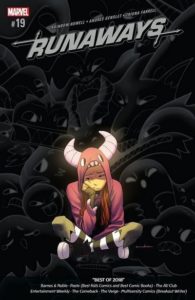 Farrell. Age of Conan: Belit, besides having a stunning cover by Sara (Monstress) Takeda, begins a five-issue origin for Conan’s pirate queen; it’s part Princess Bride, part Treasure Island, part Sinbad and part Pippi Longstocking — a lot of parts, especially for a first issue, but they fit together well enough, and that cover really is worth the $3.99 by itself. Runaways has been quietly rebuilding its fan base with a back-to-basics cast and relationships; this issue begins its fourth story arc, with Molly running off with a departing/thrown out Alex, and is a great stand-alone example of the crisp art, deep characterization, respect for previous stories, humor and drama that make it work so well.
Farrell. Age of Conan: Belit, besides having a stunning cover by Sara (Monstress) Takeda, begins a five-issue origin for Conan’s pirate queen; it’s part Princess Bride, part Treasure Island, part Sinbad and part Pippi Longstocking — a lot of parts, especially for a first issue, but they fit together well enough, and that cover really is worth the $3.99 by itself. Runaways has been quietly rebuilding its fan base with a back-to-basics cast and relationships; this issue begins its fourth story arc, with Molly running off with a departing/thrown out Alex, and is a great stand-alone example of the crisp art, deep characterization, respect for previous stories, humor and drama that make it work so well.
 Age of X-Man: Marvelous X-Men #2 (of 5) — Writers: Zac Thompson and Lonnie Nadler; Art: Marco Failla; Colors: Matt Milla
Age of X-Man: Marvelous X-Men #2 (of 5) — Writers: Zac Thompson and Lonnie Nadler; Art: Marco Failla; Colors: Matt Milla
Age of X-Man: Apocalypse and the X-Tracts #1 (of 5) — Writer: Tim Seeley; Art: Salva Espin; Colors: Israel Silva
Uncanny X-Men: Winter’s End #1 (of 1) — Writer: Sina Grace; Art: Nathan Stockman; Colors: Federico Blee
Marvel Tales: Thor #1 (of 1) — Creators: Various
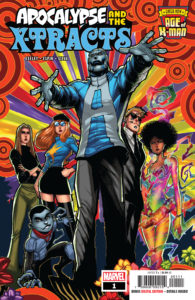 Two more Age of X-Man mini-series this week: Marvelous X-Men pits its utopian-establishment heroes (Colossus, Storm, Jean Grey, Magneto, Nightcrawler and X-Man, among others) against a group of revolutionaries, led by Apocalypse, who are spreading a hippie-like free-love religion to counter their society’s strict rules against physical affection; that group gets their own comic in Apocalypse and the X-Tracts, whose psychedelic cover (not to mention Dazzler as a beatnik singer in a Greenwich Village coffee house) emphasize the early-’60s counter-
Two more Age of X-Man mini-series this week: Marvelous X-Men pits its utopian-establishment heroes (Colossus, Storm, Jean Grey, Magneto, Nightcrawler and X-Man, among others) against a group of revolutionaries, led by Apocalypse, who are spreading a hippie-like free-love religion to counter their society’s strict rules against physical affection; that group gets their own comic in Apocalypse and the X-Tracts, whose psychedelic cover (not to mention Dazzler as a beatnik singer in a Greenwich Village coffee house) emphasize the early-’60s counter-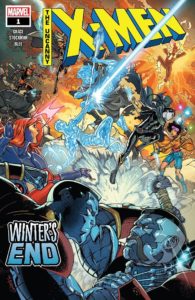 culture vibe. Uncanny X-Men: Winter’s End isn’t part of any of that; it’s an epilogue to the recently-cancelled Iceman series, giving creators Sina Grace and Nathan Stockman a giant-size comic to wrap up loose ends and leave Bobby Drake in a good place. Fans of the earlier book will want it, especially, but it works well as a solo tale of the character; if the series had been this confidently-told from the beginning, it might have lasted longer. Marvel Tales is another in a series of $7.99 jumbo reprint collections, this one focusing on Thor: you get the first Loki, a 12-page tale from the Thunder God’s third appearance, in Journey Into
culture vibe. Uncanny X-Men: Winter’s End isn’t part of any of that; it’s an epilogue to the recently-cancelled Iceman series, giving creators Sina Grace and Nathan Stockman a giant-size comic to wrap up loose ends and leave Bobby Drake in a good place. Fans of the earlier book will want it, especially, but it works well as a solo tale of the character; if the series had been this confidently-told from the beginning, it might have lasted longer. Marvel Tales is another in a series of $7.99 jumbo reprint collections, this one focusing on Thor: you get the first Loki, a 12-page tale from the Thunder God’s third appearance, in Journey Into 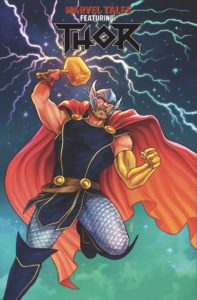 Mystery #85, with Kirby art and a Larry Lieber script over a Stan Lee plot; the 15-page lead story guest-starring Hercules, from Journey Into Mystery Annual #1, a full Lee/Kirby collaboration from 1965, near the peak of their combined powers; the first appearance of the Asgardian Valkyrie, from Avengers #83, an early-’70s Roy Thomas/John Buscema/Tom Palmer women’s-lib-themed romp; and the early-’80s debut of Walt Simonson’s long, acclaimed run on the character (and the first appearance of Beta Ray Bill), from Thor #337. Unless you have most of those books already, it’s an historically important, highly-readable bargain tour of some of Thor’s best moments, and totally worth the price.
Mystery #85, with Kirby art and a Larry Lieber script over a Stan Lee plot; the 15-page lead story guest-starring Hercules, from Journey Into Mystery Annual #1, a full Lee/Kirby collaboration from 1965, near the peak of their combined powers; the first appearance of the Asgardian Valkyrie, from Avengers #83, an early-’70s Roy Thomas/John Buscema/Tom Palmer women’s-lib-themed romp; and the early-’80s debut of Walt Simonson’s long, acclaimed run on the character (and the first appearance of Beta Ray Bill), from Thor #337. Unless you have most of those books already, it’s an historically important, highly-readable bargain tour of some of Thor’s best moments, and totally worth the price.
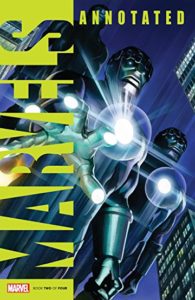 Marvels Annotated #2 (of 4) — Writer: Kurt Busiek; Art/Colors: Alex Ross
Marvels Annotated #2 (of 4) — Writer: Kurt Busiek; Art/Colors: Alex Ross
Amazing Spider-Man #17 (Legacy #818) — Writer: Nick Spencer; Pencils: Humberto Ramos; Inks: Victor Olazaba; Colors: Edgar Delgado
Avengers: Nor Road Home #5 (of 10) (Legacy #712) — Writers: Jim Zub, Mark Waid and Al Ewing; Art: Sean Izaakse; Colors: Marcio Menyz and Erick Arciniega
Tony Stark: Iron Man #9 (Legacy #609) — Writers: Dan Slott with Jim Zub; Art: Valerio Schiti and Paolo Rivera; 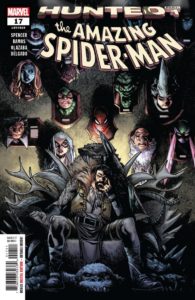 Colors: Edgar Delgado
Colors: Edgar Delgado
If you’re an aspiring comics writer, or care at all about the process of making comics, get Marvels Annotated: in addition to reprinting that seminal Kurt Busiek/Alex Ross mini-series, it includes almost 60 pages of notes: the various proposals Busiek and Ross submitted to Marvel to get the book greenlit — with an explanation of what changed and why — plus Busiek’s full final script, plus a page-by-page breakdown of the thinking that went into the various scenes, and a bunch of extra art. For $7.99, it’s an invaluable, eye-opening look at all the writing, crafting and 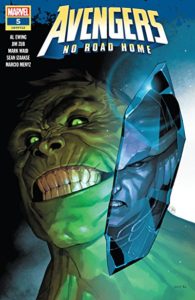 prep that goes into a series before it arrives in your hands on a Wednesday morning. Amazing Spider-Man starts its newest arc, the ten-issue, three-month “Hunted,” involving Kraven the Hunter (duh…) and a bunch of old-time Spider-villains; this week’s kick-off issue offers a 30-page story, and watching longtime Spider-artist Humberto Ramos get to draw so many iconic characters in his supple, appealing style makes it that much better. There’s also another installment of the weekly Avengers: No Road Home saga; fans of the Al Ewing Immortal Hulk book will appreciate Ewing’s writing of that character here, where he gets a major role, and between that and a bunch of
prep that goes into a series before it arrives in your hands on a Wednesday morning. Amazing Spider-Man starts its newest arc, the ten-issue, three-month “Hunted,” involving Kraven the Hunter (duh…) and a bunch of old-time Spider-villains; this week’s kick-off issue offers a 30-page story, and watching longtime Spider-artist Humberto Ramos get to draw so many iconic characters in his supple, appealing style makes it that much better. There’s also another installment of the weekly Avengers: No Road Home saga; fans of the Al Ewing Immortal Hulk book will appreciate Ewing’s writing of that character here, where he gets a major role, and between that and a bunch of 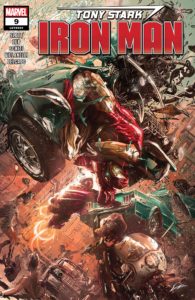 characters fighting and getting tossed around in time (leading to a last-page meeting between the Scarlet Witch and a certain surly Cimmerian), there’s plenty to reward a reader’s interest. So too for Tony Stark: Iron Man, in the middle of an involved, but engaging, initial 12-issue story about a world-wide Stark virtual-reality MUD game that gets hijacked by the Controller, offered with the same combination of precise characterization and unexpected plot twists that writer Dan Slott used to such good effect for a decade or two during his Amazing Spider-Man run. Add in a startling cliffhanger revelation about the now-VR-trapped Stark himself, and there’s more than enough to satisfy fans of the ferrous Avenger.
characters fighting and getting tossed around in time (leading to a last-page meeting between the Scarlet Witch and a certain surly Cimmerian), there’s plenty to reward a reader’s interest. So too for Tony Stark: Iron Man, in the middle of an involved, but engaging, initial 12-issue story about a world-wide Stark virtual-reality MUD game that gets hijacked by the Controller, offered with the same combination of precise characterization and unexpected plot twists that writer Dan Slott used to such good effect for a decade or two during his Amazing Spider-Man run. Add in a startling cliffhanger revelation about the now-VR-trapped Stark himself, and there’s more than enough to satisfy fans of the ferrous Avenger.
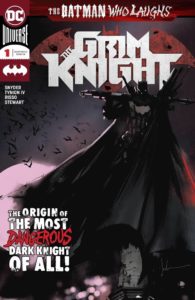 The Batman Who Laughs: The Grim Knight #1 (of 1) — Writers: Scott Snyder and James Tynion IV; Art: Eduardo Risso; Colors: Dave Stewart
The Batman Who Laughs: The Grim Knight #1 (of 1) — Writers: Scott Snyder and James Tynion IV; Art: Eduardo Risso; Colors: Dave Stewart
Superman #9 — Writer: Brian Michael Bendis; Pencils: Ivan Reis and Brandon Peterson; Inks: Joe Prado and Oclair Albert; Colors: Alex Sinclair
Cover #6 (of 6) — Writer: Brian Michael Bendis; Art: David Mack; Colors: Zu Orzu
Wonder Twins #2 — Writer: Mark Russell; Art/Colors: Stephen Byrne
 Flash #66 — Writer: Joshua Williamson; Art: Scott Kolins; Colors: Luis Guerrero
Flash #66 — Writer: Joshua Williamson; Art: Scott Kolins; Colors: Luis Guerrero
The Grim Knight is a one-shot origin of that alternate-world Batman who’s also appearing as a sidekick to the title bad guy in the Batman Who Laughs mini-series; he’s from a world where the young Bruce Wayne, after a robber shot his parents, picked up the criminal’s gun and shot him dead — leading to a Batman whose response to crime and corruption in Gotham City is simply to kill them all (upside: no costumed crazy criminals; downside: a totalitarian Big Brother bat-dictatorship). Much of this  issue has the Grim Knight explaining this to a captured Jim Gordon, and if you’re reading the Scott Snyder/James Tynion bat-stuff now (and, judging by sales on Batman Who Laughs, most of you are), then you’ll definitely want this too. Superman continues the returned Super-Son, Jon Kent, telling his parents about his adventures in outer space (the ones that caused him to come home aged to 17 instead of his previous 10); in this issue, they involve being trapped in the Crime Syndicate’s alternate universe, complete with an Ultraman who’s a dark-mirror version of his dad. It’s all just as interesting
issue has the Grim Knight explaining this to a captured Jim Gordon, and if you’re reading the Scott Snyder/James Tynion bat-stuff now (and, judging by sales on Batman Who Laughs, most of you are), then you’ll definitely want this too. Superman continues the returned Super-Son, Jon Kent, telling his parents about his adventures in outer space (the ones that caused him to come home aged to 17 instead of his previous 10); in this issue, they involve being trapped in the Crime Syndicate’s alternate universe, complete with an Ultraman who’s a dark-mirror version of his dad. It’s all just as interesting  and smoothly-told as the rest of the Brian Michael Bendis Superman books have been. That’s also been true of Bendis’s creator-owned, DC-published books: Cover, about a comics artist who gets recruited by the US government as a spy, ends its first volume with its sixth issue, and Bendis gives artist David Mack full reign to showcase his chameleon-like, often-beautiful drawing: you can see why so many top-tier artists want to partner with a writer who’s both imaginative and generous to his collaborators. Wonder Twins continues its modern-day reimagining of Jayna and Zan, the alien twins and Justice League interns of the title, as they have to battle a group of D-list villains;
and smoothly-told as the rest of the Brian Michael Bendis Superman books have been. That’s also been true of Bendis’s creator-owned, DC-published books: Cover, about a comics artist who gets recruited by the US government as a spy, ends its first volume with its sixth issue, and Bendis gives artist David Mack full reign to showcase his chameleon-like, often-beautiful drawing: you can see why so many top-tier artists want to partner with a writer who’s both imaginative and generous to his collaborators. Wonder Twins continues its modern-day reimagining of Jayna and Zan, the alien twins and Justice League interns of the title, as they have to battle a group of D-list villains;  writer Mark Russell walks a tightrope between satirical and serious (much as in his previous Flintstones series), and Stephen Byrne’s art, both cartoony and detailed, matches the mix. This is often amusing, and sometimes ridiculous, but always gets pulled back by its weird sincerity; it’s a unique voice, something comics could use more of. Flash continues to be a really good straight-ahead superhero book, befitting its linear-thinking title hero; Joshua Williamson’s been doing good things for a while with both Barry Allen and his Rogue’s Gallery (look at this issue, an origin/rebirth for the original Trickster), and Scott Kolins’s thin-lined style was made to draw speed, so a stand-alone story like this makes it a perfect jump-on issue for curious readers.
writer Mark Russell walks a tightrope between satirical and serious (much as in his previous Flintstones series), and Stephen Byrne’s art, both cartoony and detailed, matches the mix. This is often amusing, and sometimes ridiculous, but always gets pulled back by its weird sincerity; it’s a unique voice, something comics could use more of. Flash continues to be a really good straight-ahead superhero book, befitting its linear-thinking title hero; Joshua Williamson’s been doing good things for a while with both Barry Allen and his Rogue’s Gallery (look at this issue, an origin/rebirth for the original Trickster), and Scott Kolins’s thin-lined style was made to draw speed, so a stand-alone story like this makes it a perfect jump-on issue for curious readers.
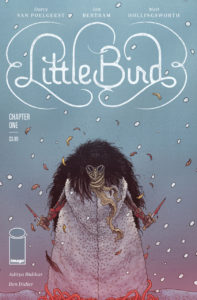 Little Bird #1 (of 5) — Writer: Darcy Van Poelgeest; Art: Ian Bertram; Colors: Matt Hollingsworth
Little Bird #1 (of 5) — Writer: Darcy Van Poelgeest; Art: Ian Bertram; Colors: Matt Hollingsworth
Assassin Nation #1 — Writer: Kyle Starks; Art/Colors: Erica Henderson
The Goon #1 — Creator: Eric Powell
Rick and Morty Presents: Jerry #1 (of 1) — Writer: Ryan Ferrier; Art: CJ Cannon; Colors: Joshua Perez
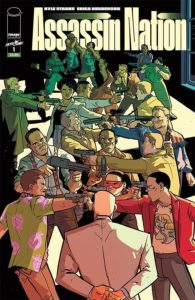 Buffy the Vampire Slayer #3 — Writer: Jordie Bellaire; Art: Dan Mora; Colors: Raul Angulo
Buffy the Vampire Slayer #3 — Writer: Jordie Bellaire; Art: Dan Mora; Colors: Raul Angulo
Hit-Girl: Season Two #2 — Writer: Kevin Smith; Art: Pernille Orum; Colors: Sunny Gho
Headlopper #11 — Writer/Artist: Andrew Maclean; Colors: Jordie Bellaire
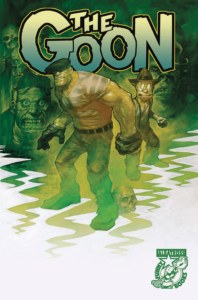 Ian Betram’s stylized, European art style is immediately recognizable; his most visible recent works have been the Marvel Secret Wars X-Men spinoff mini-series E Is For Extinction, and the indy book about the Winchester mansion, House of Penance. On Little Bird, he’s teaming with writer Darcy Van Poelgeest to tell a tale about a post-apocalyptic Canada fighting with a religious-war-minded “United Nations of America,” and a young girl who has to seek out the imprisoned fighter who may be able to turn the tide.
Ian Betram’s stylized, European art style is immediately recognizable; his most visible recent works have been the Marvel Secret Wars X-Men spinoff mini-series E Is For Extinction, and the indy book about the Winchester mansion, House of Penance. On Little Bird, he’s teaming with writer Darcy Van Poelgeest to tell a tale about a post-apocalyptic Canada fighting with a religious-war-minded “United Nations of America,” and a young girl who has to seek out the imprisoned fighter who may be able to turn the tide. 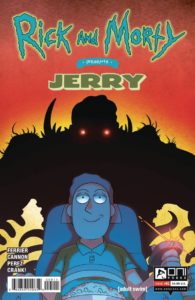 Great-looking and densely-plotted, it rewards multiple readings; it’s received quite a bit of pre-publication buzz, and it looks like it might be deserved. Assassin Nation is about a gathering of the 50 best hitmen in the world; a former #1 on that list is being stalked, and wants to hire everyone to protect him. It’s got a more-than-decent pedigree: Kyle Starks has written a bunch of the Rick and Morty comics and made them almost as good as the show, no simple feat, while the art is by the amazing Erica Henderson, who proves her
Great-looking and densely-plotted, it rewards multiple readings; it’s received quite a bit of pre-publication buzz, and it looks like it might be deserved. Assassin Nation is about a gathering of the 50 best hitmen in the world; a former #1 on that list is being stalked, and wants to hire everyone to protect him. It’s got a more-than-decent pedigree: Kyle Starks has written a bunch of the Rick and Morty comics and made them almost as good as the show, no simple feat, while the art is by the amazing Erica Henderson, who proves her  versatility by moving from a sunny comic where no one ever dies (Squirrel Girl) to this one, where most of the cast, in fact, do — and not losing a bit of her dramatic/humorous style or quality. Eric Powell’s long-running tough-guy comic The Goon knows about how to walk that comedy/drama line, too, and its return with a new #1 issue this week is welcome: Powell’s brawling script, ink-shadowed art and fondness for the supernatural make it look like Popeye, if that superhuman sailor had been part of the EC horror line. Rick and Morty
versatility by moving from a sunny comic where no one ever dies (Squirrel Girl) to this one, where most of the cast, in fact, do — and not losing a bit of her dramatic/humorous style or quality. Eric Powell’s long-running tough-guy comic The Goon knows about how to walk that comedy/drama line, too, and its return with a new #1 issue this week is welcome: Powell’s brawling script, ink-shadowed art and fondness for the supernatural make it look like Popeye, if that superhuman sailor had been part of the EC horror line. Rick and Morty 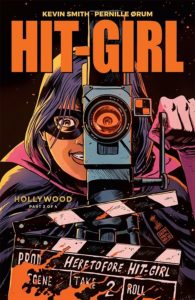 Presents, a series of one-shot specials, focuses on the hapless Jerry this month; the art’s by regular R&M contributor CJ Cannon, so if you like the main book then you’ll like this too. Buffy the Vampire Slayer continues not being just a rehash of the early episodes of the TV series (it’s only issue #3, and Spike and Drusilla have already shown up), with that nonchalance about previous continuity making the plots more surprising, and thus better; if it’s able to retain old fans while attracting new ones, then more power to it. Hit-Girl: Season Two continues to be interesting mostly because of its writer: Kevin
Presents, a series of one-shot specials, focuses on the hapless Jerry this month; the art’s by regular R&M contributor CJ Cannon, so if you like the main book then you’ll like this too. Buffy the Vampire Slayer continues not being just a rehash of the early episodes of the TV series (it’s only issue #3, and Spike and Drusilla have already shown up), with that nonchalance about previous continuity making the plots more surprising, and thus better; if it’s able to retain old fans while attracting new ones, then more power to it. Hit-Girl: Season Two continues to be interesting mostly because of its writer: Kevin  Smith, who crafts a Hollywood-oriented adventure (they’re making an unauthorized movie about the title heroine, and she isn’t happy about it); this leads to just the kind of insider satire and revenge fantasy against rapist studio heads and other villains that you’d expect, and since it’s just a four-issue arc I’m more than happy to stick around for it. Headlopper continues Andrew Maclean’s quarterly Conan-if-he’d-appeared-in-Heavy-Metal fantasy romp; between Jordie Bellaire’s psychedelic coloring and Maclean’s Jack Kirby-meets-Moebius art, it’s always welcome– and another of those comics that, if you pick it up and casually flip through it on the stands, will likely hook you for life.
Smith, who crafts a Hollywood-oriented adventure (they’re making an unauthorized movie about the title heroine, and she isn’t happy about it); this leads to just the kind of insider satire and revenge fantasy against rapist studio heads and other villains that you’d expect, and since it’s just a four-issue arc I’m more than happy to stick around for it. Headlopper continues Andrew Maclean’s quarterly Conan-if-he’d-appeared-in-Heavy-Metal fantasy romp; between Jordie Bellaire’s psychedelic coloring and Maclean’s Jack Kirby-meets-Moebius art, it’s always welcome– and another of those comics that, if you pick it up and casually flip through it on the stands, will likely hook you for life.



